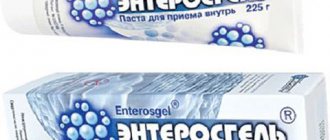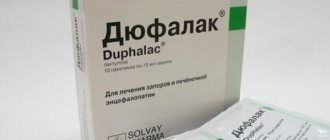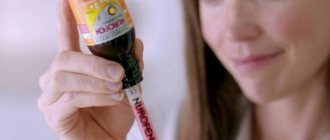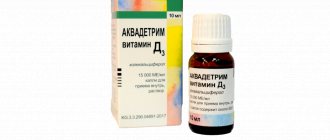Enterosgel is a drug that has absorption properties. Due to its properties and active substance, the drug, like a sponge, absorbs toxic substances produced during metabolism
A child has been poisoned by some low-quality product, what should I do? It is recommended to use the drug “Enterosgel”, which will help the child’s body cope with poisoning. How to give Enterosgel if the child is 4 years old ? What is the method of application? Are there any contraindications? How to store the product? – you will learn all this information in this article!
Description of the medication: composition and release form
Enterosgel can be classified as a new generation of absorbents. Unlike conventional activated carbon, it has a spongy structure. Due to the presence of peculiar pores, the composition selectively binds toxins and gradually removes them from the body. The drug is presented in several dosage forms:
- Sweet paste. The active component is polymethylsiloxane polyhydrate. Purified water and sweeteners E952, E954 are used as excipients. The paste is packaged in tubes (90, 225 g) and double-layer bags (15, 22 g). You can also purchase the option in cans of 135, 270 and 405 g.
- Jelly-like gel, odorless. Includes 100% active ingredient. The composition contains small lumps of white color. For packaging, the manufacturer uses 225 g jars and plastic bags.
Due to the presence of sweeteners, the paste should be given with caution to children with allergies. Unlike gel, it does not require preparation.
Pharmacological properties
The active substance of the drug does not stick to the mucous membranes of the digestive tract and does not cause damage to the epithelial layer. It binds harmful and poisonous substances to the body and subsequently removes them naturally along with feces. The product is effective against medium molecular toxic structures, which include:
- pathogenic flora;
- waste products of pathogenic microorganisms;
- food allergens;
- heavy metals, their salts;
- toxic substances found in medications;
- industrial poisons;
- antigens;
- excess urea;
- bad cholesterol;
- bilirubin.
"Enterosgel" cleanses the body even of alcohol vapors. That is why it is so often prescribed to young patients who are forced to take medications containing ethanol.
The drug does not have a pronounced effect on the peristalsis of the intestinal walls. In the case of course use, it significantly improves the absorption of individual vitamins, restores the balance of intestinal microflora, which was disturbed due to the use of antibiotics or intestinal infection.
How safe are the vaccines themselves?
Traditionally, vaccines are divided into live (weakened) and “killed” (containing only parts of microorganisms, for example, inactivated toxins [2]). New technologies have given the world genomic and vector vaccines. Some newly developed vaccines may not be sufficiently capable of inducing lasting immunity (immunogenicity). Because these vaccines lack those structures that interact with receptors in the body during real infection. In this case, adjuvants are used - substances that can stimulate the immune response [3].
Undoubtedly, the use of different types of vaccines has its own risks [4]. Live vaccines may not be weakened enough and begin to synthesize toxins, which manifests itself in specific symptoms of the disease. And parts of microorganisms are substances foreign to humans, so vaccination may cause a flu-like condition or even severe signs of intoxication. There is also a risk of an immune reaction that is too strong (anaphylaxis and other allergic reactions). Vaccination creates an additional load on the immune system, and therefore a person must be prepared for such a load, therefore vaccination is carried out under the mandatory supervision of qualified doctors.
Bibliography
- The date for the next phase of testing the Russian COVID vaccine has been announced | Coronavirus COVID–19: Official information about coronavirus in Russia on the portal - stopcoronavirus.rf [Electronic resource]. URL: https://stopcoronavirus.rf/news/20200716-1552.html (date of access: 07.17.2020).;
- Plotkin SA Vaccines: Past, present and future // Nat. Med. Nature Publishing Group, 2005. Vol. 11, No. 4S. S. S5.;
- Semakova A.P., Mikshis N.I. Adjuvant technologies in the creation of modern vaccines // Problems of especially dangerous infections. 2021. T. 2. pp. 28–35.;
- Francis MJ Recent Advances in Vaccine Technologies // Veterinary Clinics of North America - Small Animal Practice. WB Saunders, 2021. Vol. 48, No. 2. pp. 231–241.;
- Khovanov A.V. Enterosgel in dermatology: approaches to the treatment of atopic dermatitis and food allergies. Chief Physician of the South of Russia 2015, 2, 50–53.;
Indications for use
According to the instructions for use, Enterosgel for children is prescribed for any conditions accompanied by severe intoxication. These include:
- allergies, including to medications and food;
- poisoning with low-quality products, industrial poisons, chemicals, expired medications;
- intestinal infections;
- dysbacteriosis;
- diarrhea;
- blood diseases accompanied by purulent-necrotic processes;
- pathologies in which an increase in the level of bilirubin in the blood is recorded;
- severe disturbances in liver function;
- chronic intoxication caused by living in unfavorable conditions and passive smoking.
For preventive purposes, the absorbent is prescribed during the introduction of complementary foods to children prone to allergies. It is also effective when moving to an area with different climatic conditions, when many babies in the first year of life experience digestive disorders.
How to avoid dysbacteriosis?
- We already know that dysbiosis (dysbacteriosis) is a consequence of various factors, and not a disease. The pediatrician will advise you on how to avoid digestive problems.
- Make every possible and impossible effort - breastfeed your child, but if for some reason the child is transferred to artificial feeding, consult with your pediatrician which formula to choose. Start your baby's first feeding with special children's fermented milk products.
- Take your child outside for walks more often.
- Do not overfeed if the child has no appetite. Do not force feed when the baby is sick or has had an illness. Poorly digested food will cause discomfort, problems with stool and abdominal pain.
- Do not introduce new foods to your baby’s diet during illness.
Dosage regimen
Most parents buy sweet Enterosgel for their children. Instructions for use and dosage regimen do not differ depending on the dosage form of the drug. Their effectiveness is also approximately the same. However, sweet toothpaste is much easier to give to a capricious or picky child.
It is recommended to give the composition before the immediate meal (1-2 hours before). It should first be dissolved in water, the volume of which is approximately 3 times the dose of the paste. It can be given to babies unchanged, but after the procedure it is necessary to ensure that the little patient drinks enough water. Infants may mix the product with breast milk, juice or other drinks. However, in this case, it is better to choose odorless and tasteless Enterosgel for treatment.
For children, instructions for use may vary depending on age:
- babies of the first year of life are given 2.5 g of the composition up to 6 times a day;
- children from 1 to 5 years old - 7.5 g three times a day;
- from 5 to 14 years - 15 g 3 times a day.
The daily dosage in the first days of treatment can be increased, but only on the recommendations of a doctor.
How to give Enterosgel to a 4 year old child - basic tips
A 4-year-old child should be given a medication suspension. To do this, pour a certain amount of the product, which is dissolved in water at a ratio of 1 to 3. The suspension can be drunk 2 hours before eating or 2 hours after eating.
Moreover, before using the drug “Enterosgel”, you need to find out what disease you want to cure in a 4-year-old child; he is allergic to the components of this drug. In case of acute illness, the dose can be increased by 1.5 times, but do not drink more of the drug unless absolutely necessary, otherwise you will cause intoxication or addiction to the drug.
Duration of therapy
Treatment with Enterosgel for children usually lasts for at least 3 and no more than 5 days in a row. In chronic forms of intoxication, the duration of therapy increases and ranges from 10 days to 3 weeks.
If the doctor prescribed the drug for preventive purposes, for example in case of exposure to adverse factors, it is recommended to use the product for 7-10 days, but every month. Maintenance dosage is always calculated on an individual basis.
What conclusions should loving parents draw?
- Dysbacteriosis is not a disease, but the result of “failures” in the body.
- Many diseases can cause dysbacteriosis (dysbiosis).
- Many medications can cause dysbiosis (especially when self-medicated).
- The problem can be solved by eliminating the cause of dysbiosis.
- Dysbacteriosis has no specific signs (symptoms).
Remember: Enterosgel helps normalize intestinal function and biocenosis and can help with this and other conditions, poisoning, allergies in infants and more!
Side effects
Adverse reactions with the correct dosage of Enterosgel for children occur extremely rarely. Constipation may occur in the first days of therapy. If it does not cause discomfort to the child and lasts no more than two days, there is no need to discontinue the drug. To eliminate it faster, you can give more fluids to drink.
Some patients may experience nausea or a feeling of disgust towards their composition while taking the paste or gel. It goes away on its own.
Contraindications for use
The absorbent in any form should not be given to small patients with individual intolerance to the main component. "Enterosgel" for children under one year of age with an allergy to sweeteners in the composition or intolerance to sulfonamide compounds is prohibited.
Another important contraindication is intestinal atony. This is a condition in which the muscles of the organ cannot contract with the necessary force, as a result of which there is often a complete lack of peristalsis. In this case, the absorbent will only worsen the condition of the little patient. Also limiting its use is the presence of bleeding in the digestive tract and intestinal obstruction. For the listed pathologies, it is not sorbents that are needed, but emergency medical care.
If "friendly" bacteria can't be delivered to the small intestine, how did they get there in the first place?
A child is born like a white sheet of paper, his intestines are still sterile. During the first hours of life, beneficial bacteria begin to colonize the crypts of the small intestine. They enter the baby's body from the mother - through touch and milk. The baby's gastric juice does not contain hydrochloric acid, so microorganisms safely reach the small intestine unharmed.
By the way, do you know why a person needs an appendix? Previously, it was considered an unnecessary appendage that could put its owner on the operating table. In the United States in the last century, the appendix was removed for all newborns. Science does not stand still. As a result of numerous studies, the benefits of the appendix have been proven. It turns out that the vermiform appendix of the cecum serves as an incubator for beneficial bacteria and a reliable refuge under conditions unfavorable for microflora. Thanks to the appendix, new portions of friendly microorganisms again and again populate the small intestine.
Terms of sale and storage
According to reviews, Enterosgel is an indispensable remedy for children with diarrhea and other intestinal disorders. Therefore, many parents always have it in their home medicine cabinet. This is an over-the-counter product. It is produced by a Russian company, which means there should be no difficulties purchasing it at a pharmacy. The cost varies depending on the region of sale, as a rule, it is about 400 rubles.
Enterosgel is often used by parents to prevent rotavirus in children. They are forced to keep a small supply of the drug at home. To ensure that the therapeutic properties are not lost, it must be stored correctly:
- the room temperature should not exceed 30 degrees;
- the tube with the drug can be kept in the refrigerator, but it should not be allowed to freeze;
- The packaging must always remain tightly closed.
If the above conditions are met, the shelf life will be 3 years.
special instructions
Since the sorbent is a completely safe substance that is not absorbed into the general bloodstream, it is harmless to the body and does not accumulate in it. Therefore, the drug cannot cause an overdose.
As already mentioned, the gel can reduce the effectiveness of other medications, so it should be taken some time after taking the main drug. The drug can be used in complex treatment.
If Enterosgel is given to an infant, all lumps should be thoroughly rubbed into liquid. Dispensed from pharmacies without a doctor's prescription. Shelf life: 3 years.
Popular analogues
Instead of the absorbent described in the article, you can take other drugs with similar therapeutic effects. Popular analogues of Enterosgel for children are the following:
- Activated carbon. This is the most popular sorbent. The drug is prescribed to children for salmonellosis, flatulence, food poisoning, vomiting and other conditions. Among the main advantages, parents note availability in pharmacies and low cost.
- "Polysorb MP". The medication is available in powder form, which must be mixed with water at home to obtain a suspension. Prescribed for diarrhea, food poisoning, diathesis. The active substance is colloidal silicon dioxide. It binds toxins, helping to gently remove them from the body.
- "Smecta". The medication can be purchased in the form of a powder or a ready-made suspension. Prescribed for vomiting, allergies and other ailments. The main advantages of Smecta are the natural origin of the active substance, portioned release form, and high efficiency.
- "Enterodesis." The domestic sorbent is produced in the form of powder, packaged in sachets. The composition contains povidone, a substance that binds harmful substances and accelerates their transport from the body. The drug is used for burn disease, kidney failure, and infectious pathologies.
There are other sorbents that are safe for use in children. However, before starting to use any drug, you should consult a doctor who can determine the correct dosage.
Why do you need to dilute the product?
The porous structure of Enterosgel absorbs all harmful toxins and decay products of microorganisms. Enterosgel not only removes harmful substances from the body, but also envelops the mucous membrane of the digestive tract. Thus, this paste reduces irritation of the mucous membrane and restores it during the inflammatory process.
Enterosgel can be used by both adults and children. A safe medicine has certain healing properties in the human body:
- improves recovery reactions;
- regenerates affected areas of the mucosa;
- prevents further development of infection;
- relieves intoxication and dehydration.
However, before taking Enterosgel it is necessary to dilute it with water. This helps to liquefy the gel substance, as a result of which the medicinal mass becomes more liquid and completely fills the cavities of the stomach and intestines. It is also necessary to dilute Enterosgel with water for better absorption of toxins. The absorbent absorbs harmful substances and removes them from the body with biological fluids. Before use, it is important to dilute Enterosgel in water.
Main indications for taking the drug:
- intestinal infections of various types;
- allergy;
- intoxication of the body;
- poisoning with harmful substances;
- acne.
Reviews from parents
The opinions of parents and doctors of various specialties about Enterosgel are in most cases positive. This drug is highly effective, quickly eliminates unpleasant symptoms, and is convenient and safe to use. Mothers of children in their first year of life prefer the option without sweetener. They mix the composition in artificial formula or breast milk. Parents of older children usually prefer the sweet drug.
Another important advantage is the wide range of indications. According to reviews, Enterosgel for children with vomiting or diarrhea quickly relieves the disorder. Therefore, the absorbent is present in the first aid kit of all parents, and some even take it with them on trips.
Among the disadvantages, it is necessary to note the high cost. For this reason, the drug is often replaced with cheaper analogues. There are also complaints about unpleasant taste and unusual consistency.











